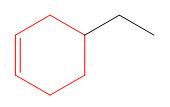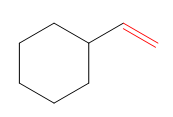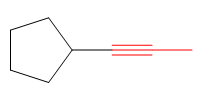
Concept explainers
(a)
Interpretation:
The root for the given molecule is to be determined.
Concept introduction:
In case of molecules containing a
Answer to Problem B.1P
The root for the given molecule is cyclohexene.
Explanation of Solution
The given molecule is

In this molecule, the largest ring containing the double bond has six carbon atoms. Hence, the root is cyclohexene, as shown below.

The root is determined from the longest carbon chain or the largest ring containing the double or triple bond between the carbon atoms.
(b)
Interpretation:
The root for the given molecule is to be determined.
Concept introduction:
In case of molecules containing a
Answer to Problem B.1P
The root for the given molecule is ethene.
Explanation of Solution
The given molecule is

In this molecule, the double bond is a part of the chain attached to the ring. Although the ring has more carbon atoms than the side chain, the ring does not contain a

The root is determined from the longest carbon chain or the largest ring containing the double or triple bond between the carbon atoms.
(c)
Interpretation:
The root for the given molecule is to be determined.
Concept introduction:
In case of molecules containing a
Answer to Problem B.1P
The root for the given molecule is propyne.
Explanation of Solution
The given molecule is

In this molecule, the triple bond is a part of the chain attached to the ring. Although the ring has more carbon atoms than the side chain, the ring does not contain a

The root is determined from the longest carbon chain or the largest ring containing the double or triple bond between the carbon atoms.
(d)
Interpretation:
The root for the given molecule is to be determined.
Concept introduction:
In case of molecules containing a
Answer to Problem B.1P
The root for the given molecule is hexene.
Explanation of Solution
The given molecule is

In this molecule, the longest carbon chain containing the double bond has six carbon atoms. Hence, the root is hexene, as shown below.

The root is determined from the longest carbon chain or the largest ring containing the double or triple bond between the carbon atoms.
Want to see more full solutions like this?
Chapter B Solutions
EBK ORGANIC CHEMISTRY: PRINCIPLES AND M
- Indicate the products obtained by mixing 2,2-dimethylpropanal with acetaldehyde and sodium ethoxide in ethanol.arrow_forwardSynthesize 2-Ethyl-3-methyloxirane from dimethyl(propyl)sulfonium iodide using the necessary organic or inorganic reagents. Draw the structures of the compounds.arrow_forwardSynthesize 2-Hydroxy-2-phenylacetonitrile from phenylmethanol using the necessary organic or inorganic reagents. Draw the structures of the compounds.arrow_forward
- Synthesize N-Methylcyclohexylamine from cyclohexanol using the necessary organic or inorganic reagents. Draw the structures of the compounds.arrow_forwardSynthesize N-Methylcyclohexylamine from cyclohexanol using the necessary organic or inorganic reagents. Draw the structures of the compounds.arrow_forwardIf possible, please provide the formula of the compound 3,3-dimethylbut-2-enal.arrow_forward
- Synthesize 1,4-dibromobenzene from acetanilide (N-phenylacetamide) using the necessary organic or inorganic reagents. Draw the structures of the compounds.arrow_forwardIndicate the products obtained by mixing (3-oxo-3-phenylpropyl)triphenylphosphonium bromide with sodium hydride.arrow_forwardWe mix N-ethyl-2-hexanamine with excess methyl iodide and followed by heating with aqueous Ag2O. Indicate the major products obtained.arrow_forward
- Indicate the products obtained by mixing acetophenone with iodine and NaOH.arrow_forwardIndicate the products obtained by mixing 2-Propanone and ethyllithium and performing a subsequent acid hydrolysis.arrow_forwardIndicate the products obtained if (E)-2-butenal and 3-oxo-butanenitrile are mixed with sodium ethoxide in ethanol.arrow_forward
 Organic Chemistry: A Guided InquiryChemistryISBN:9780618974122Author:Andrei StraumanisPublisher:Cengage Learning
Organic Chemistry: A Guided InquiryChemistryISBN:9780618974122Author:Andrei StraumanisPublisher:Cengage Learning Chemistry for Today: General, Organic, and Bioche...ChemistryISBN:9781305960060Author:Spencer L. Seager, Michael R. Slabaugh, Maren S. HansenPublisher:Cengage Learning
Chemistry for Today: General, Organic, and Bioche...ChemistryISBN:9781305960060Author:Spencer L. Seager, Michael R. Slabaugh, Maren S. HansenPublisher:Cengage Learning

